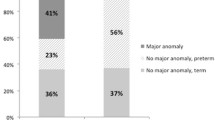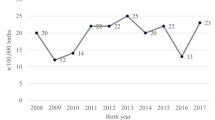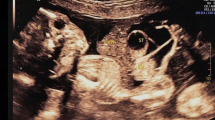Abstract
The study aimed to analyse the clinical courses of aggressively treated neonates with cytogenetically confirmed trisomy 18, with special attention focused on the efficiency of prenatal diagnostics, associated malformations, therapeutic dilemmas and outcomes. We investigated retrospectively the data concerning 20 neonates with trisomy 18, admitted to the Neonatal Intensive Care Unit (NICU) in Katowice between January 2000 and February 2005. Their birth weights ranged from 650 g to 2400 g, mean 1812 g; gestational age ranged from 27 to 42 weeks, median 38 weeks. Intrauterine growth retardation was noticed in 90% of neonates. Trisomy 18 was suspected prenatally in 40% of cases. Most (80%) of newborns were delivered by caesarean section (92% of neonates with prenatally unrecognized chromosomal defects, 62% of neonates with trisomy 18 suspicion) and 70% of infants needed respiratory support immediately after birth. Cardiac defects were present in 95%, central nervous system malformations in 65%, severe anomalies of digestive system or abdominal wall in 25% of patients. Nine surgical operations were performed during hospitalization (4 were palliative cardiac surgeries). Six patients (30%) survived the neonatal period and were discharged from the NICU. The median survival of the neonates who died was 20 days. In 4 cases cardiac problems implicated their death; in others, deaths were attributed to multiorgan failure, prematurity and/or infection. Further improvement of efficiency of prenatal ultrasound screening for diagnosis of trisomy 18 in the fetus is necessary. A lack of prenatal diagnosis of trisomy 18 in the fetus results in a high rate of unnecessary caesarean sections in these pregnancies. Despite the aggressive treatment most neonates with trisomy 18 died during the neonatal period. The majority of deaths were attributed to cardiorespiratory and multiorgan failure. Concerning the poor prognosis, prompt karyotyping (using FISH) of clinically suspected trisomy 18 is very important, because many invasive procedures and surgeries may then be avoided.
Similar content being viewed by others
References
Baty BJ, Blackburn BL, Carey JC, 1994. Natural history of trisomy 18 and trisomy 13: Growth, physical assessment, medical histories, survival, and recurrence risk. Am J Med Genet 49: 175–188.
Bos AP, Broers CJ, Hazebroek FW, van Hemel JO, Tibboel D, Wesby-Van Swaay E, Molenmar JC, 1992. Avoidance of emergency surgery in newborn infants with trisomy 18. Lancet 339: 913–917.
Carter PE, Pearn JH, Bell J, Martin N, Andreson NG, 1985. Survival in trisomy 18: life tables for use in genetic counselling and clinical paediatrics. Clin Genet 27: 59–61.
Chitty LS, 1995. Ultrasound screening for fetal abnormalities. Prenat Diagn 15: 1241–1257.
De Vigan C, Baena N, Cariati E, Clementi M, Stoll C, and the EUROSCAN working group, 2001. Contribution of ultrasonographic examination to the prenatal detection of chromosomal abnormalities in 19 centres across Europe. Ann Genet 44: 209–217.
DeVore GR, 2000. Second trimester ultrasonography may identify 77–95% of fetuses with trisomy 18. J Ultrasound Med 19: 565–576.
Embleton ND, Wyllie JP, Wright MJ, Burn J, Hunter S, 1996. Natural history of trisomy 18. Arch Dis Child 75: 38–41.
Grandjean H, Larroque D, Levi S, 1998. Detection of chromosomal abnormalities, an outcome of ultrasound screening. The Eurofets Team Ann NY Acad Sci 18: 136–140.
Hodes ME, Cole J, Palmer CG, Reed T, 1978. Clinical experience with trisomies 18 and 13. J Med Genet 15: 48–60.
Moran CJ, Tay JB, Morrison JJ, 2002. Ultrasound detection and perinatal outcome of fetal trisomies 21, 18 and 13 in the absence of a routine fetal anomaly scan or biochemical screening. Ultrasound Obstet Gynecol 20: 482–485.
Musewe NN, Alexander DJ, Teshima I, Smallhorn JF, Freedom RM, 1990. Echocardiographic evaluation of the spectrum of cardiac anomalies associated with trisomy 13 and trisomy 18. JACC 15: 673–677.
Nicolaides KH, Azar G, Byrne D, Mansur C, Marks K, 1992. Fetal nuchal translucency: ultrasound screening for chromosomal defects in first trimester of pregnancy. BMJ 304: 967–969.
Rasmussen SA, Lee-Yang CW, Quanhe Yang, May KM, Friedman JM, 2003. Population-based analyses of mortality in trisomy 13 and trisomy 18. Pediatrics 111: 777–784.
Root S, Carey JC, 1994. Survival in trisomy 18. Am J Med Genet 49: 170–174.
Smith DW, 1988. Trisomy 18 syndrome. In: Jones K.L., ed. Smith’s recognizable patterns of human malformation. Philadelphia, Saunders: 16–19.
Van Praagh S, Truman T, Firpo A, 1989. Cardiac malformations in trisomy 18: a study of 41 postmortem cases. J Am Coll Cardiol 13: 1586–1597.
Wojciechowska E, Włoch A, Szydłowski L, Włoch St, Goc B, Walencka Z, et al. 2005. Trisomy 18 ultrasound-based diagnosis in the third-trimester prenatal diagnosis and what next? J Ped Neonatal 2: 54–58.
Author information
Authors and Affiliations
Corresponding author
Rights and permissions
About this article
Cite this article
Goc, B., Walencka, Z., Włoch, A. et al. Trisomy 18 in neonates: prenatal diagnosis, clinical features, therapeutic dilemmas and outcome. J Appl Genet 47, 165–170 (2006). https://doi.org/10.1007/BF03194617
Received:
Revised:
Accepted:
Issue Date:
DOI: https://doi.org/10.1007/BF03194617




